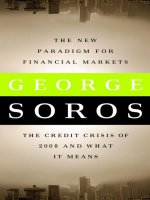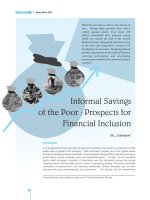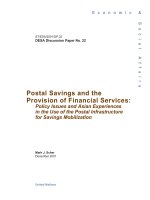The little book that builds wealth the knockout formula for finding great investments
Bạn đang xem bản rút gọn của tài liệu. Xem và tải ngay bản đầy đủ của tài liệu tại đây (1.7 MB, 223 trang )
T
ITTLE BOO
L
K
HE
THAT
BUILDS
WEALTH
The Knockout Formula
for Finding Great Investments
PAT DORSEY
FOREWORD BY JOE MANSUETO
FOUNDER, CHAIRMAN, AND CEO OF MORNINGSTAR, INC.
John Wiley & Sons, Inc.
ffirs.indd v
2/1/08 12:55:38 PM
ffirs.indd iv
2/1/08 12:55:38 PM
T
K
H
ITTLE BO
L
O
E
THAT
BUILDS
WEALTH
ffirs.indd i
2/1/08 12:55:36 PM
Little Book Big Profits Series
In the Little Book Big Profits series, the brightest icons in the financial
world write on topics that range from tried-and-true investment strategies to tomorrow’s new trends. Each book offers a unique perspective
on investing, allowing the reader to pick and choose from the very
best in investment advice today.
Books in the Little Book Big Profits series include:
The Little Book That Beats the Market, where Joel Greenblatt, founder
and managing partner at Gotham Capital, reveals a “magic formula”
that is easy to use and makes buying good companies at bargain
prices automatic, enabling you to successfully beat the market and
professional managers by a wide margin.
The Little Book of Value Investing, where Christopher Browne, managing director of Tweedy, Browne Company, LLC, the oldest value
investing firm on Wall Street, simply and succinctly explains how
value investing, one of the most effective investment strategies ever
created, works, and shows you how it can be applied globally.
The Little Book of Common Sense Investing, where Vanguard Group
founder John C. Bogle shares his own time-tested philosophies,
lessons, and personal anecdotes to explain why outperforming the
market is an investor illusion, and how the simplest of investment
ffirs.indd ii
2/1/08 12:55:37 PM
strategies—indexing—can deliver the greatest return to the greatest
number of investors.
The Little Book That Makes You Rich, where Louis Navellier, financial analyst and editor of investment newsletters since 1980, offers
readers a fundamental understanding of how to get rich using the
best in growth investing strategies. Filled with in-depth insights and
practical advice, The Little Book That Makes You Rich outlines an
effective approach to building true wealth in today’s markets.
The Little Book That Builds Wealth, where Pat Dorsey, director of
stock research for leading independent investment research provider
Morningstar, Inc., guides the reader in understanding “economic
moats,” learning how to measure them against one another, and
selecting the best companies for the very best returns.
ffirs.indd iii
2/1/08 12:55:37 PM
ffirs.indd iv
2/1/08 12:55:38 PM
T
ITTLE BOO
L
K
HE
THAT
BUILDS
WEALTH
The Knockout Formula
for Finding Great Investments
PAT DORSEY
FOREWORD BY JOE MANSUETO
FOUNDER, CHAIRMAN, AND CEO OF MORNINGSTAR, INC.
John Wiley & Sons, Inc.
ffirs.indd v
2/1/08 12:55:38 PM
Copyright © 2008 by Morningstar, Inc. All rights reserved.
Published by John Wiley & Sons, Inc., Hoboken, New Jersey.
Published simultaneously in Canada.
No part of this publication may be reproduced, stored in a retrieval system, or transmitted in any form or
by any means, electronic, mechanical, photocopying, recording, scanning, or otherwise, except as
permitted under Section 107 or 108 of the 1976 United States Copyright Act, without either the prior
written permission of the Publisher, or authorization through payment of the appropriate per-copy fee to
the Copyright Clearance Center, Inc., 222 Rosewood Drive, Danvers, MA 01923, (978) 750-8400, fax
(978) 646-8600, or on the web at www.copyright.com. Requests to the Publisher for permission should be
addressed to the Permissions Department, John Wiley & Sons, Inc., 111 River Street, Hoboken, NJ
07030, (201) 748-6011, fax (201) 748-6008, or online at />Limit of Liability/Disclaimer of Warranty: While the publisher and author have used their best efforts
in preparing this book, they make no representations or warranties with respect to the accuracy or
completeness of the contents of this book and specifically disclaim any implied warranties of
merchantability or fitness for a particular purpose. No warranty may be created or extended by sales
representatives or written sales materials. The advice and strategies contained herein may not be
suitable for your situation. You should consult with a professional where appropriate. Neither the
publisher nor author shall be liable for any loss of profit or any other commercial damages, including
but not limited to special, incidental, consequential, or other damages.
For general information on our other products and services or for technical support, please contact our
Customer Care Department within the United States at (800) 762-2974, outside the United States at
(317) 572-3993 or fax (317) 572-4002.
Wiley also publishes its books in a variety of electronic formats. Some content that appears in print
may not be available in electronic books. For more information about Wiley products, visit our web site
at www.wiley.com.
Library of Congress Cataloging-in-Publication Data:
Dorsey, Pat.
The little book that builds wealth : Morningstar’s knockout formula for finding great investments /
Patrick Dorsey.
p. cm.—(Little book big profits series)
Includes index.
ISBN 978-0-470-22651-3 (cloth)
1. Investments. 2. Stocks. 3. Investment analysis. I. Morningstar, Inc. II. Title.
HG4521.D6463 2008
332.6—dc22
2007045591
Printed in the United States of America.
10
ffirs.indd vi
9
8
7
6
5
4
3
2
1
2/1/08 12:55:38 PM
Contents
Foreword
Acknowledgments
xi
xvii
Introduction
The Game Plan
1
Chapter One
Economic Moats
7
Chapter Two
Mistaken Moats
15
Chapter Three
Intangible Assets
ftoc.indd vii
29
2/1/08 12:56:10 PM
[viii]
C O N T E N TS
Chapter Four
Switching Costs
43
Chapter Five
The Network Effect
57
Chapter Six
Cost Advantages
75
Chapter Seven
The Size Advantage
91
Chapter Eight
Eroding Moats
103
Chapter Nine
Finding Moats
115
Chapter Ten
The Big Boss
133
Chapter Eleven
Where the Rubber Meets the Road
ftoc.indd viii
143
2/1/08 12:56:10 PM
C O N T E N TS
[ix]
Chapter Twelve
What’s a Moat Worth?
159
Chapter Thirteen
Tools for Valuation
171
Chapter Fourteen
When to Sell
187
Conclusion
More than Numbers
ftoc.indd ix
197
2/1/08 12:56:10 PM
ftoc.indd x
2/1/08 12:56:10 PM
Foreword
WHEN I STARTED Morningstar in 1984, my goal was to help
individuals invest in mutual funds. Back then, a few financial
publications carried performance data, and that was about
it. By providing institutional-quality information at affordable prices, I thought we could meet a growing need.
But I also had another goal. I wanted to build a business
with an “economic moat.” Warren Buffett coined this term,
which refers to the sustainable advantages that protect a company against competitors—the way a moat protects a castle.
I discovered Buffett in the early 1980s and studied Berkshire Hathaway’s annual reports. There Buffett explains the
moat concept, and I thought I could use this insight to help
flast.indd xi
2/1/08 12:56:30 PM
[xii]
F O R E WO R D
build a business. Economic moats made so much sense to
me that the concept is the foundation for our company and
for our stock analysis.
I saw a clear market need when I started Morningstar, but I also wanted a business with the potential for a
moat. Why spend time, money, and energy only to watch
competitors take away our customers?
The business I envisioned would be hard for a competitor to replicate. I wanted Morningstar’s economic moat to
include a trusted brand, large financial databases, proprietary analytics, a sizable and knowledgeable analyst staff,
and a large and loyal customer base. With my background
in investing, a growing market need, and a business model
that had wide-moat potential, I embarked on my journey.
Over the past 23 years, Morningstar has achieved
considerable success. The company now has revenues of
more than $400 million, with above-average profitability.
We’ve worked hard to make our moat broader and deeper,
and we keep these goals in mind whenever we make new
investments in our business.
Moats, however, are also the basis of Morningstar’s
approach to stock investing. We believe investors should
focus their long-term investments on companies with
wide economic moats. These companies can earn excess
returns for extended periods—above-average gains that
should be recognized over time in share prices. There’s
flast.indd xii
2/1/08 12:56:30 PM
F O R E WO R D
[xiii]
another plus: You can hold these stocks longer, and that
reduces trading costs. So wide-moat companies are great
candidates for anyone’s core portfolio.
Many people invest by reacting: “My brother-in-law
recommended it” or “I read about it in Money.” It’s also
easy to get distracted by daily price gyrations and pundits
who pontificate about short-term market swings. Far better
to a have a conceptual anchor to help you evaluate stocks
and build a rational portfolio. That’s where moats are
invaluable.
While Buffett developed the moat concept, we’ve
taken the idea one step further. We’ve identified the most
common attributes of moats, such as high switching costs
and economies of scale, and provided a full analysis of
these attributes. Although investing remains an art, we’ve
attempted to make identifying companies with moats more
of a science.
Moats are a crucial element in Morningstar’s stock
ratings. We have more than 100 stock analysts covering
2,000 publicly traded companies across 100 industries. Two
main factors determine our ratings: (1) a stock’s discount
from our estimated fair value, and (2) the size of a company’s moat. Each analyst builds a detailed discounted cash
flow model to arrive at a company’s fair value. The analyst
then assigns a moat rating—Wide, Narrow, or None—
based on the techniques that you’ll learn about in this
flast.indd xiii
2/1/08 12:56:30 PM
[xiv]
F O R E WO R D
book. The larger the discount to fair value and the larger
the moat, the higher the Morningstar stock rating.
We’re seeking companies with moats, but we want to
buy them at a significant discount to fair value. This is what
the best investors do—legends like Buffett, Bill Nygren at
Oakmark Funds, and Mason Hawkins at Longleaf Funds.
Morningstar, though, consistently applies this methodology
across a broad spectrum of companies.
This broad coverage gives us a unique perspective on the
qualities that can give companies a sustainable competitive
advantage. Our stock analysts regularly debate moats with
their peers and defend their moat ratings to our senior staff.
Moats are an important part of the culture at Morningstar
and a central theme in our analyst reports.
In this book, Pat Dorsey, who heads up our stock
research at Morningstar, takes our collective experience and
shares it with you. He gives you an inside look at the thought
process we use in evaluating companies at Morningstar.
Pat has been instrumental in the development of our
stock research and our economic moat ratings. He is sharp,
well-informed, and experienced. We’re also fortunate that
Pat is a top-notch communicator—both in writing and
speaking (you’ll often see him on television). As you’re
about to find out, Pat has a rare ability to explain investing
in a clear and entertaining way.
flast.indd xiv
2/1/08 12:56:30 PM
F O R E WO R D
[xv]
In the pages that follow, Pat explains why we think
making investment decisions based on companies’ economic moats is such a smart long-term approach—and,
most important, how you can use this approach to build
wealth over time. You’ll learn how to identify companies
with moats and gain tools for determining how much a
stock is worth, all in a very accessible and engaging way.
Throughout the book, you’ll learn about the economic
power of moats by studying how specific companies with
wide moats have generated above-average profits over
many years—whereas businesses lacking moats have often
failed to create value for shareholders over time.
Haywood Kelly, our chief of securities analysis, and
Catherine Odelbo, president of our Individual Investor
business, have also played a central role in developing
Morningstar’s stock research. Our entire stock analyst
staff also deserves much credit for doing high-quality
moat analysis on a daily basis.
This book is short. But if you read it carefully, I
believe you’ll develop a solid foundation for making smart
investment decisions. I wish you well in your investments
and hope you enjoy our Little Book.
—JOE MANSUETO
FOUNDER, CHAIRMAN, AND CEO, MORNINGSTAR, INC.
flast.indd xv
2/1/08 12:56:31 PM
flast.indd xvi
2/1/08 12:56:31 PM
Acknowledgments
ANY BOOK IS A TEAM effort, and this one is no exception.
I am very lucky to work with a group of extremely talented analysts, without whom I would know far less about
investing than I do. The contributions of Morningstar’s
Equity Analyst staff improved this book considerably,
especially when it came to making sure I had just the
right example to illustrate a particular point. It’s a blast
to have such sharp colleagues—they make it fun to come
in to work every day.
Special thanks go to Haywood Kelly, Morningstar’s
chief of securities analysis, for valuable editorial feedback—
and for hiring me at Morningstar many years ago. I’m
flast.indd xvii
2/1/08 12:56:31 PM
[xviii]
A C K N OW L E D G M E N TS
also grateful to director of stock analysis Heather Brilliant
for quickly and seamlessly shouldering my managerial
duties while I completed this book. Last but not least, Chris
Cantore turned ideas into graphics, Karen Wallace tightened my prose, and Maureen Dahlen and Sara Mersinger
kept the project on track. Thanks to all four.
Credit is also due to Catherine Odelbo, president of
securities analysis, for her leadership of Morningstar’s equity
research efforts, and of course to Morningstar founder Joe
Mansueto for building a world-class firm that always puts
investors first. Thanks, Joe.
No one, however, deserves more gratitude than my
wife Katherine, whose love and support are my most precious assets. Along with little Ben and Alice, our twins,
she brings happiness to each day.
flast.indd xviii
2/1/08 12:56:31 PM
T
K
H
ITTLE BO
L
O
E
THAT
BUILDS
WEALTH
flast.indd xix
2/1/08 12:56:32 PM
flast.indd xx
2/1/08 12:56:32 PM
Int
roduction
The Game Plan
THERE ARE LOTS OF WAYS to make money in the stock market.
You can play the Wall Street game, keep a sharp eye on
trends, and try to guess which companies will beat earnings
estimates each quarter, but you’ll face quite a lot of competition. You can buy strong stocks with bullish chart patterns
or superfast growth, but you’ll run the risk that no buyers
will emerge to take the shares off your hands at a higher
price. You can buy dirt-cheap stocks with little regard for
the quality of the underlying business, but you’ll have to
balance the outsize returns in the stocks that bounce back
with the losses in those that fade from existence.
cintro.indd 1
1/26/08 3:14:59 AM
[2]
T H E L I T T L E B O O K T H AT B U I L D S W E A LT H
Or you can simply buy wonderful companies at reasonable prices, and let those companies compound cash
over long periods of time. Surprisingly, there aren’t all
that many money managers who follow this strategy, even
though it’s the one used by some of the world’s most successful investors. (Warren Buffett is the best-known.)
The game plan you need to follow to implement this
strategy is simple:
1. Identify businesses that can generate above-average
profits for many years.
2. Wait until the shares of those businesses trade for
less than their intrinsic value, and then buy.
3. Hold those shares until either the business deteriorates, the shares become overvalued, or you find a
better investment. This holding period should be
measured in years, not months.
4. Repeat as necessary.
This Little Book is largely about the first step—finding
wonderful businesses with long-term potential. If you can
do this, you’ll already be ahead of most investors. Later in
the book, I’ll give you some tips on valuing stocks, as well
as some guidance on when you want to sell a stock and
move on to the next opportunity.
cintro.indd 2
1/26/08 3:14:59 AM









